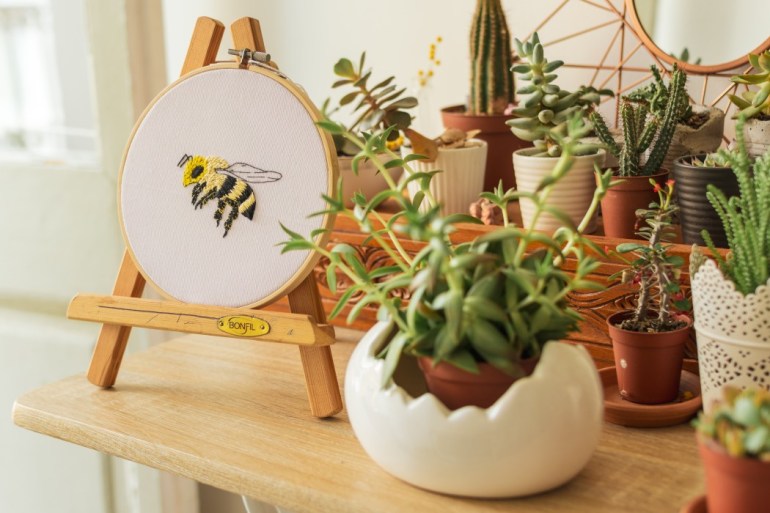It seems nature reigns supreme in the world of embroidery. Seven out of the top 10 most popular embroidery designs were nature-related.
The research was carried out by embroidery design experts Design Bundles. They carried out an investigation using online search results to find out which embroidery patterns were searched for most often in the UK. It seems that nature is in vogue as these embroidery types dominated the top 10.
Flowers were the overwhelming favourite of all the embroidery patterns. Over a three-month period, flower embroidery designs were searched for 4,400 times each month. This was nearly four times as popular as the next most favoured embroidery design.
But why are flowers so popular in sewing? Apart from the obvious beauty, they are a highly decorative and versatile pattern. Flowers also have an illustrious history in needlework. This is due to floriography – the language of flowers. Floriography assigns meaning to different flowers, and the practice (although named in the 19th century) dates back to ancient Greece and ancient Rome. Flowers were used to adorn poets and victors in the Roman Empire.
Floriography fell out of fashion with the fall of the Roman empire but was reignited in the middle ages. Knights would show their devotion to the woman they loved by colouring their casques with her colour. She in turn would wear flowers matching the colour on her dress.

The practice of gifting a bouquet of flowers was said to have originated in Turkey. And, in the 18th century that ‘secret flower language’ was brought to Europe by Lady Mary Wortley Montagu who wrote letters from the Turkish Embassy to England. She stated:
“There is no colour, no flower, no weed, no fruit, herb, pebble, or feather that has not a verse belonging to it: and you may quarrel, reproach, or send letters of passion, friendship, or civility or even of news, without ever inking your fingers”.
In the victorian age woman oppressed by the strict morality of the era had little outlet to express their desires. Creating expressive hand embroidery allowed them to secretly say in stitching what was not socially acceptable at the time. The secret symbolism of flowers became a secret stitched code. For example, the strawberry flower embroidery design represented esteem and love as the pattern was symbolic of natural perfection.
This flower-inspired symbolism continues today most notably in the different meanings of roses. It is little wonder that flowers are among the most popular themes in embroidery.
Along with flower needlework nature continues to represent the most popular embroidery designs in the UK as shown below.

Top 10 most popular embroidery patterns in the UK
| Embroidery Patterns | Average Monthly Searches |
| Embroidery Flowers | 4,400 |
| Logo Embroidery | 1,600 |
| Bee Embroidery | 1,000 |
| Butterfly Embroidery | 880 |
| Rose Embroidery | 880 |
| Sunflower Embroidery | 880 |
| Sweet Pea Embroidery | 880 |
| Christmas Embroidery | 720 |
| Leaf Embroidery | 720 |
| Name Embroidery | 590 |
Second most popular embroidery design
Breaking the trend at number two is the logo embroidery design. With 1600 searches each month it is one of only three embroidery design motifs, not nature themed. Of course, this type of embroidery design seeks to create a business logo for marketing purposes. A stitched logo can use elements of nearly any design on the top ten. Meaning logo embroidery designs are versatile and can also be nature-related.
Bee embroidery design (1000 searches)
“If the bee disappeared off the face of the Earth, man would only have four years left to live.” This quote (though unproven) is said to be attributed to Albert Einstein. The popularity of this quote represents the increase in appreciation and awareness of the bee. Bee-friendly initiatives have become commonplace and this may explain why the bee embroidery design is so popular.

Whether hand stitched or using sewing machines the bee is a popular addition to craft projects. The eye-catching black and yellow contrasting stitching is another reason why the bee is one of the most popular motifs to create.
Butterfly embroidery design (880 searches)
Another nature-inspired embroidery design is the butterfly sewing pattern. Butterfly motifs symbolise re-birth or transformation. This is why so many people ink the pattern into their skin with tattoos. Other forms of butterfly-inspired art include sewing motifs.
Butterfly embroidery designs are decorations doe cushion covers and wall hangings because of their positive meaning. The butterfly may be more colourful than other motifs meaning an embroidery project could be trickier yet more beautiful.
A variety of filling stitches can be used in butterfly embroidery designs. This includes:
- Satin stitch
- French knots
- Blanket stitches
- Long & short stitch
- Stem stitch
Rose embroidery design (880 searches)
Floriography is again represented in decorative arts with rose embroidery. An embroidery project can symbolise a variety of meanings such as friendship, gratitude and love. Rose stitching patterns are likely to have been more popular in the winter months because of its proximity to valentines day. Hand embroidered needlework is an incredibly thoughtful valentines present.
English embroidery designs often contain a rose pattern as the English rose was adopted as England’s national symbol after the war of the roses.
The rest of the top 10 most searched for embroidery designs

The rose style completed the top five most popular embroidery designs. Natural dominated with three other forms of embroidery. These remaining three styles of needlework included:
- Sunflower needlework
- Sweet pea needlework
- Leaf needlework
The other two pattern ideas were Christmas embroidery and name embroidery. Notable examples of different stitches, styles, and embroidery that may be used to create the listed designs include:
- Satin stitch
- Couching stitch
- Cross stitch
- Chain stitch
- Basic stitches
- Jacobean embroidery
- Stem stitch
- Surface embroidery
- Buttonhole stitch
- Crewel work
- Raised work





